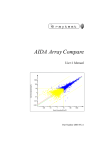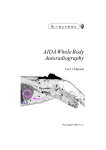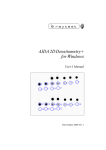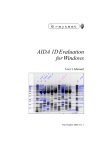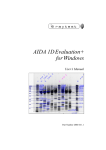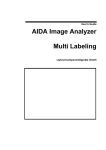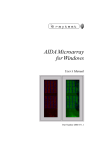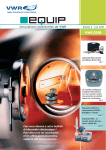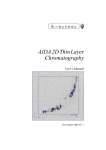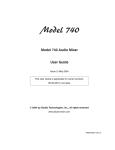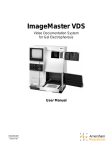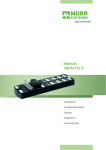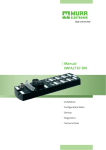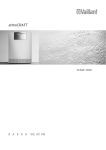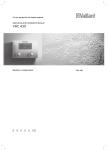Download AIDA Image Analyzer for Windows User's Manual
Transcript
raytest AIDA Image Analyzer for Windows Basic Concepts and Features User’s Manual Part Number 2003 09 1.1 raytest © 2003 r a y t e s t Isotopenmeßgeräte GmbH, Benzstr. 4, D-75334 Straubenhardt, Germany. All rights reserved. This product or document is protected by copyright and distributed under licenses restricting its use, copying, distribution and decompilation. No part of this product or document may be reproduced in any form by any means without prior written authorization of r a y t e s t and its licensors, if any. RESTRICTED RIGHTS LEGEND: Use, duplication, or disclosure by the government is subject to restrictions as set forth in subparagraph (c)(1)(ii) of the Rights in Technical Data and Computer Software clause at DFARS 252.227-7013 and FAR 52.227-19. The product described in this manual may be protected by one or more U.S. patents, foreign patents, or pending applications. TRADEMARKS AIDA, AIDA Image Analyzer, AIDA Annotation, AIDA Array Metrix, AIDA Array Compare, AIDA Multi Labeling, AIDA 1D Evaluation, AIDA 1D Densitometry, AIDA 2D Densitometry, AIDA Easy Array, AIDA Whole Body Autoradiography, AIDA 1D Thin Layer Chromatography and AIDA 2D Thin Layer Chromatography are trademarks or registered trademarks of r a y t e s t in the United States and may be protected as trademark in other countries. All other product, service, or company names mentioned herein are claimed as trademarks and trade names by their respective companies. THIS PUBLICATION IS PROVIDED “AS IS” WITHOUT WARRANTY OF ANY KIND, EITHER EXPRESS OR IMPLIED, INCLUDING, BUT NOT LIMITED TO, THE IMPLIED WARRANTIES OF MERCHANTABILITY, FITNESS FOR A PARTICULAR PURPOSE, OR NON-INFRINGEMENT. THIS PUBLICATION COULD INCLUDE TECHNICAL INACCURACIES OR TYPOGRAPHICAL ERRORS. CHANGES ARE PERIODICALLY ADDED TO THE INFORMATION HEREIN, THESE CHANGES WILL BE INCORPORATED IN NEW EDITIONS OF THE PUBLICATION. r a y t e s t MAY MAKE IMPROVEMENTS AND/OR CHANGES IN THE PRODUCT(S) AND/OR THE PROGRAMS(S) DESCRIBED IN THIS PUBLICATION AT ANY TIME. Contents raytest 1 Introduction Overview . . . . . . . . . . . . . . . . . . . . . . . . . . . . . . . . . . . . . . . . . . . . . . . . . . . . . . . . . . . . System Requirements . . . . . . . . . . . . . . . . . . . . . . . . . . . . . . . . . . . . . . . . . . . . . . . . . . Installing AIDA Image Analyzer. . . . . . . . . . . . . . . . . . . . . . . . . . . . . . . . . . . . . . . . . . Starting AIDA Image Analyzer . . . . . . . . . . . . . . . . . . . . . . . . . . . . . . . . . . . . . . . . . . . Dongle Protection . . . . . . . . . . . . . . . . . . . . . . . . . . . . . . . . . . . . . . . . . . . . . . . . . . . . . Licensing Key . . . . . . . . . . . . . . . . . . . . . . . . . . . . . . . . . . . . . . . . . . . . . . . . . . . . . . . . Problems . . . . . . . . . . . . . . . . . . . . . . . . . . . . . . . . . . . . . . . . . . . . . . . . . . . . . . . . . . . . 2 5 5 6 6 7 8 8 8 General Information 11 Program Structure . . . . . . . . . . . . . . . . . . . . . . . . . . . . . . . . . . . . . . . . . . . . . . . . . . . . 11 Available AIDA Modules . . . . . . . . . . . . . . . . . . . . . . . . . . . . . . . . . . . . . . . . . . . . . . 12 Data Structure . . . . . . . . . . . . . . . . . . . . . . . . . . . . . . . . . . . . . . . . . . . . . . . . . . . . . . . 12 Create User Registration . . . . . . . . . . . . . . . . . . . . . . . . . . . . . . . . . . . . . . . . . . . . . . . 16 Overlays. . . . . . . . . . . . . . . . . . . . . . . . . . . . . . . . . . . . . . . . . . . . . . . . . . . . . . . . . . . . 21 Data Windows . . . . . . . . . . . . . . . . . . . . . . . . . . . . . . . . . . . . . . . . . . . . . . . . . . . . . . . 22 Main Menus . . . . . . . . . . . . . . . . . . . . . . . . . . . . . . . . . . . . . . . . . . . . . . . . . . . . . . . . . 22 File Menu . . . . . . . . . . . . . . . . . . . . . . . . . . . . . . . . . . . . . . . . . . . . . . . . . . . . . . . . 23 Edit Menu . . . . . . . . . . . . . . . . . . . . . . . . . . . . . . . . . . . . . . . . . . . . . . . . . . . . . . . . 24 Evaluation Menu. . . . . . . . . . . . . . . . . . . . . . . . . . . . . . . . . . . . . . . . . . . . . . . . . . . 25 Options Menu . . . . . . . . . . . . . . . . . . . . . . . . . . . . . . . . . . . . . . . . . . . . . . . . . . . . . 25 View Menu . . . . . . . . . . . . . . . . . . . . . . . . . . . . . . . . . . . . . . . . . . . . . . . . . . . . . . . 29 Window Menu . . . . . . . . . . . . . . . . . . . . . . . . . . . . . . . . . . . . . . . . . . . . . . . . . . . . 29 Toolbox Control Menu . . . . . . . . . . . . . . . . . . . . . . . . . . . . . . . . . . . . . . . . . . . . . . 30 Toolbar Structure . . . . . . . . . . . . . . . . . . . . . . . . . . . . . . . . . . . . . . . . . . . . . . . . . . . . . 30 File Bevel Buttons (Left Pane) . . . . . . . . . . . . . . . . . . . . . . . . . . . . . . . . . . . . . . . . 31 Visual Tools (Middle Pane) . . . . . . . . . . . . . . . . . . . . . . . . . . . . . . . . . . . . . . . . . . 31 Evaluation Push Button (Right Pane – First Half) . . . . . . . . . . . . . . . . . . . . . . . . . 33 Toolbox Bevel Buttons (Right pane - Second half) . . . . . . . . . . . . . . . . . . . . . . . . 34 Contextual Menus . . . . . . . . . . . . . . . . . . . . . . . . . . . . . . . . . . . . . . . . . . . . . . . . . . 34 iii raytest 3 iv AIDA Basic 37 Data Windows in AIDA Basic. . . . . . . . . . . . . . . . . . . . . . . . . . . . . . . . . . . . . . . . . . . 37 Image Window . . . . . . . . . . . . . . . . . . . . . . . . . . . . . . . . . . . . . . . . . . . . . . . . . . . . 38 Contextual Menu of the Image Window . . . . . . . . . . . . . . . . . . . . . . . . . . . . . 39 Histogram Window . . . . . . . . . . . . . . . . . . . . . . . . . . . . . . . . . . . . . . . . . . . . . . . . . 40 Contextual Menu of the Histogram Window . . . . . . . . . . . . . . . . . . . . . . . . . . 40 Toolboxes of AIDA Basic . . . . . . . . . . . . . . . . . . . . . . . . . . . . . . . . . . . . . . . . . . . . . . 42 Display Control Toolbox. . . . . . . . . . . . . . . . . . . . . . . . . . . . . . . . . . . . . . . . . . . . . 42 Transfer Control Pane . . . . . . . . . . . . . . . . . . . . . . . . . . . . . . . . . . . . . . . . . . . 43 Range Control Pane . . . . . . . . . . . . . . . . . . . . . . . . . . . . . . . . . . . . . . . . . . . . . 43 Gamma Control Pane . . . . . . . . . . . . . . . . . . . . . . . . . . . . . . . . . . . . . . . . . . . . 44 Palette Control Pane. . . . . . . . . . . . . . . . . . . . . . . . . . . . . . . . . . . . . . . . . . . . . 44 Orientation Control Pane . . . . . . . . . . . . . . . . . . . . . . . . . . . . . . . . . . . . . . . . . 44 Publishing Layout Toolbox . . . . . . . . . . . . . . . . . . . . . . . . . . . . . . . . . . . . . . . . . . . . . 45 Annotate Control Pane . . . . . . . . . . . . . . . . . . . . . . . . . . . . . . . . . . . . . . . . . . . . . . 45 Protocol Print Control Pane. . . . . . . . . . . . . . . . . . . . . . . . . . . . . . . . . . . . . . . . . . . 48 Print Options for Page Layout . . . . . . . . . . . . . . . . . . . . . . . . . . . . . . . . . . . . . 48 Print Options for Image Window. . . . . . . . . . . . . . . . . . . . . . . . . . . . . . . . . . . 49 Print . . . . . . . . . . . . . . . . . . . . . . . . . . . . . . . . . . . . . . . . . . . . . . . . . . . . . . . . . . . . . . . 50 Print Preview . . . . . . . . . . . . . . . . . . . . . . . . . . . . . . . . . . . . . . . . . . . . . . . . . . . . . . . . 51 Export and Import . . . . . . . . . . . . . . . . . . . . . . . . . . . . . . . . . . . . . . . . . . . . . . . . . . . . 52 Exporting and Importing Templates . . . . . . . . . . . . . . . . . . . . . . . . . . . . . . . . . . . . 52 Exporting Images . . . . . . . . . . . . . . . . . . . . . . . . . . . . . . . . . . . . . . . . . . . . . . . . . . 53 Saving Images as TIFF file . . . . . . . . . . . . . . . . . . . . . . . . . . . . . . . . . . . . . . . . . . . 54 AIDA Image Analyzer User’s Manual (Windows) Introduction 1 raytest Overview The AIDA Image Analyzer software is intended for the evaluation and annotation of images that were obtained by digital optical devices such as CCD cameras, flatbed scanners, fluorescence scanners like FLA scanners, or radioluminography scanners like BAS scanners from Fuji. In addition, the software allows the user to load and evaluate images of other types (e.g. TIF, bitmap). AIDA Image Analyzer can utilize any scanning device that offers a TWAIN compatible driver. The drivers for r a y t e s t products are included in the software package. The software concept is modular. Besides more general modules like 1D Evaluation or 2D Densitometry, there are specialized modules for high density array evaluation, multi labelling etc. AIDA provides you with specialized modules for all relevant Bio Imaging tasks. Images can be turned, flipped, enlarged, and zoomed. The grayscale representation of the image intensities can be changed to enhance the visibility of the original data. To comply with GLP standards, the original image data are never changed, so you can keep them safely on CD-ROM. All information about the representation of the image and all result data are saved in an extra file that is kept separate from the original image data. 1D application modules allow you to evaluate profiles. Densitometer windows of any width or angle can be drawn through the image. Bands and the direction of the lanes can be detected automatically. The densitometer windows can be used for quantification, the evaluation of RF values or molecular weights, utilizing standards that are present in the same image. AIDA can use calibration standards to convert the relative intensity integrals to absolute measurements (e.g. µg, nmol). The calibration curve can be reviewed and adapted to fit various functions. Molecular masses, DNA sizes, isoelectric points and RF values can be calculated from the migration distance by the use of internal standards. When multiple standard lanes are present, the image distortion (e. g. due to the smiling effect of the gels) is automatically taken into account for the calculation of these parameters. 5 1 raytest With 2D application modules you can specify and evaluate image regions. The 2D features facilitate the evaluation of full body autoradiographies, intensities in 2D gels, spots in thin layer chromatography, CAT assays, or fluorescence in microtitre plates. The features of the Array module including the import of name tables, automatic positioning of measurement dots, background subtraction, and normalization allows you to evaluate all kinds of array experiments in life science. Tags and labels can be superimposed on the image and are stored as overlays, separate from the image data. The overlays can be turned, resized, and reformatted in any way to improve the readability and the representation of the results. The results obtained with AIDA can be printed together with the image, showing the lanes or regions they originated from. The printouts can be fully configured to show various information, tables and overlays. Note – In this HELP all names of user interface elements (e. g. menus, menu items, windows, or buttons) are printed in bold typeface. System Requirements AIDA Image Analyzer's minimum system requirements are as follows: • Intel Pentium compatible CPU • One of the following operating systems: • Microsoft Windows 9x/Me • Microsoft Windows NT 4.0 • Microsoft Windows 2000: Table 0-1 Memory Requirements Windows 9x Windows ME Windows NT 4.0 Windows 2000 minimum 32 MB 64 MB 64 MB 128 MB recommended 64 MB 128 MB 128 MB 256 MB • CD-ROM drive • Graphics adapter capable of displaying at least 1024 by 768 pixels in High or True Color mode • 17'' color monitor (21'' color monitor recommended) 6 AIDA Image Analyzer User’s Manual (Windows) 1 raytest Installing AIDA Image Analyzer 1 Insert the CD-ROM in the CD-ROM drive on your computer. 2 Choose Run from the Windows Start menu to display the Run dialog box. 3 Then type the following and click OK: "drive:\Aida Image Analyzer\Setup.exe" where drive is the CD-ROM drive identifier. 4 The install wizard guides you through the installation process. Click Next to proceed through the steps. The Setup program installs the AIDA Image Analyzer program on your hard drive and creates a new group called Aida in the Windows Programs menu of your taskbar. You can start AIDA Array Compare by selecting it from the Aida cascading menu. Do not attempt to merely copy the files on the disk, since this will not result in a successful installation of the program. Starting AIDA Image Analyzer 1 Make sure, that the dongle is connected to the parallel port of your computer. 2 Double-click on the Aida Image Analyzer icon on your desktop or alternatively click Start, choose Programs and select the Aida Image Analyzer item from the Aida submenu. 3 Type your licence code in the text boxes of the AIDA License dialog box that appears. Introduction 7 1 raytest In case you lost your license code, call your AIDA vendor and tell him the serial number displayed in the dialog box. Note – The first startup of AIDA should be done by a user with administrator privileges, otherwise AIDA will not remember the license code and you will have to retype it on each start. Dongle Protection Figure 1-1 Dongle Hardware Key The full version of the AIDA software is protected by a dongle hardware key. Before you can start the program, you have to plug the dongle into the parallel port of your computer. If your printer cable is also attached to this port, turn on the printer before starting AIDA. This will avoid possible problems in recognizing the dongle by AIDA. 8 AIDA Image Analyzer User’s Manual (Windows) 1 raytest Other problems in recognizing the dongle can be caused by further dongles attached to your system. In this case be sure that the AIDA dongle is the first one on port. Since AIDA dongle is fully transparent it does not effect the other dongles. Note – There is only one dongle for all AIDA products, so there is no piling up of AIDA dongles at your parallel port. Licensing Key If you have downloaded AIDA Image Analyzer from our website, you need a license number to unlock the software. When you install the software, an hardware installationspecific serial number is automatically generated. If you start AIDA Image Analyzer the first time, a dialog box appears, asking you to enter your license number. To get this licensing key, you must register your AIDA copy by contacting the r a y t e s t customer service online or via phone/FAX specifying the serial number given in the Serial # text box of the Aida License dialog box. If you choose to register online, complete and submit the web registration form. You will get your licensing number via e-mail within a few days. The obtained license grants you a trail period of 30 days during which the software is full functional. After the trial period has expired, you have to purchase the software in order to carry on using it. Figure 1-2 License Expired Message Box On purchase you get the program CD containing the purchased AIDA application modules together with a dongle hardware key (see above) and a permanent license number required to unlock the software. Introduction 9 1 raytest Problems Some problems might arise during the use of AIDA. Please check first if your computer system is running smooth with regular software, like word processors or graphical programs. If the problems continue though other software runs fine, we would like to know about your problems. Please report the problem together with your hard and software settings to raytest, so that we will be able to fix it in the next update of the program. 10 AIDA Image Analyzer User’s Manual (Windows) General Information 2 raytest Program Structure The AIDA Image Analyzer program is a typical Windowsprogram. All standard Windows functions, like moving and re-sizing windows, clicking buttons and using toolboxes are exactly as described in the Windows manual. To keep this manual short, all functions that are generally used by Windows programs are not explained in detail. This manual assumes that you are familiar with Windows. The term clicking always implies the use of the left mouse button. The use of the right mouse button will be explicitly mentioned. For multiple selections, first click an item, then hold down the Shift key while selecting another one to ensure that all items between those two in the list are selected. To select two or more non-adjacent items, click an item, then click another one while holding down the Ctrl key. Holding down the Ctrl key and clicking an item a second time will deselect it. Menus and toolbars allow a user to interact with the AIDA program. Most functions are accessible by clicking the appropriate button on the toolbar as well as by clicking the appropriate item on a menu. Both, the toolbar and the menu, change depending on the active window and toolbox within the AIDA program. Windows within AIDA can display images, profiles, reports and curves. Some functions (shown in gray) are only accessible when certain actions have already been performed. Functions activated by buttons from the toolbar or from menus always affect the currently active window. You can distinguish the active window from the inactive ones by the different color of the title bar. Just click on the desired window to make it active. Current messages are displayed in the status bar at the bottom of the screen. The appearance of the status bar also depends on the active window. AIDA Image Analyzer is a modular program. In the Evaluation menu you can choose from the available functions, whereas the basic functionality is build into the integrating software. 11 2 raytest Whenever you switch from one evaluation to a another one, the results of the actual evaluation will be stored in the Array Data File (.adf) before a new evaluation can be started. Available AIDA Modules The following modules are currently available for AIDA Image Analyzer (indention indicates a subset relation between modules): Built-in module: Annotation 1D application modules: 1D Multi Labeling 1D Evaluation 1D Densitometry Run Length Determination 2D application modules: 2D Multi Labeling 2D Densitometry Array modules: Array Metrix Easy Array Whole Body Autoradiography application modules: Whole Body Autoradiography Thin Layer Chromatography application modules 1D Thin Layer Chromatography 2D Thin Layer Chromatography All these modules can be purchased separately, except for the Annotation module, which is a built-in module of the AIDA Image Analyzer integrating software. 12 AIDA Image Analyzer User’s Manual (Windows) 2 raytest Data Structure All information processed by AIDA is based on images. The program was originally developed for the evaluation of images obtained by r a y t e s t CCD cameras and Fuji BAS scanners, which use different file formats to store image data. In addition to r a y t e s t and Fuji files, AIDA Image Analyzer can import data files created by other hardware and software. Table 0-1 Image Data Format Accessible by AIDA Image Analyzer Input Device Original Image Data Format CCD camera, desktop scanner Fuji BAS *.tif *.img *.pcb *.inf Fuji FLA *.img *.pcb *.inf Fuji LAS MD Phosphor Imager *.img *.inf *.gel AIDA generates an *.ADF file that contains all information related to the image (overlays, image representation, result data, etc.). The original image data are left unchanged. Opening an ADF file opens the image and all related settings. A backup file (.ad~ extension) is kept, which can be opened if necessary and should in this case be saved with the *.ADF extension for further use. Note – The ADF file and the original image file should be kept in the same directory, unless the image file is read from CD or server. Images can be autoradiographs, video images or scans of gels, thin layer chromatography, western, northern, and southern blots. Images can have a dynamic range (data depth) of 8 to 16 bit, resulting in 255 to 65535 grayscales. Images can be evaluated using different tools (e.g. 1D Evaluation or 2D Densitometry) and saved under different names. However, multiple evaluation modes can not be used simultaneously. The current evaluation will be stored with the current image settings before the next evaluation can be started. General Information 13 2 raytest To review the image and evaluation file information for the current data set, choose Information from the File menu. Figure 2-1 Choosing Information Command from File Menu This opens the File Information dialog box. The File Information dialog box consists of three tabbed pages. The Image tab displays information about the image and the parameter file. The path to the files, the creation date of the image file, and the image resolution are shown. For scanner images the image size, resolution, pixel size, and (depending on the data format of the image) the filename 14 AIDA Image Analyzer User’s Manual (Windows) 2 raytest originally used to store the scanned image are given. For camera images only the dynamic range and the resolution are given. The dynamic range (in this example 1024 grayscales) and the total size of the image are displayed. Figure 2-2 File Information Dialog Box (Image Tab) On the Exposure tab, additional information about the measurement and the device that created the image is shown. It might be omitted if the device or image format does not support further exposure information. Figure 2-3 File Information Dialog Box (Exposure Tab) General Information 15 2 raytest The Evaluation tab contains information about the evaluation file. Comments can be added for future reference. Figure 2-4 File Information Dialog Box (Evaluation Tab) Create User Registration Access control to AIDA might be required when working under Good Laboratory Practice (GLP) conditions. AIDA provides three different types of users, a System Administrator, Administrators and normal Users. The System Administrator is a fixed account in AIDA which cannot be changed or deleted. When no password is set for the System Administrator, the user registration in AIDA is deactivated. Administrators have the permission to create, modify and delete users or administrators. For GLP relevant modifications of the program settings, general administrator rights are required in AIDA. Users can modify their own password. They have access to the normal functionality of AIDA. 16 AIDA Image Analyzer User’s Manual (Windows) 2 raytest When the user registration is activated, you must type your user name and password before you get access to the program. Figure 2-5 AIDA Registration Login Dialog Box To activate the user registration in AIDA the first time, you must enter a password for the system administrator account. To enter the password for the system administrator account: 1 Choose Create User Registration from the Options menu. The AIDA Registration User Management Setup dialog box appears. 2 Type a password for the system administrator account in the Password text field of the Aida Registration User Management Setup dialog box and confirm the new password by retyping it in the Confirm Password field. Figure 2-6 Entering Administrator Password 3 Click OK to apply the changes. Now the user registration is activated and only registered operators have access to the program. General Information 17 2 raytest When the user registration is activated and the operator has administrator privileges, the User Registration command is selectable from the Options menu. On choosing this command, the AIDA Registration User Management dialog box appears, allowing you to add new users or to modify or delete existing user accounts. Figure 2-7 AIDA Registration User Management Dialog Box To add new users: 1 On the AIDA Registration User Management dialog box click Add to open the Add User dialog box. Figure 2-8 Adding Users 2 Type a user name, full name, and password for the new user, and confirm the password by retyping it in the Confirm password field. A User name can consist of up to 31 characters and must be unique in the registration database. 18 AIDA Image Analyzer User’s Manual (Windows) 2 raytest The Full name is used whenever the program has to display the name of the operator (e.g. on print outs). It cannot be longer than 63 characters. The user’s Password must contain at least 4 characters (maximum 8 characters). Note – In previous AIDA releases, the Password text field allowed to enter passwords with more than 8 characters without warning you, that internally only the first 8 characters of the password are processed. In this release, the behavior of the text field has been adjusted to reflect this fact properly by restricting the input of password to at least 4 and at most 8 characters. Users, whose old password exceeds 8 characters can use the first 8 characters of the old password as a valid new password without changing anything else (just type in the characters until the text field warns you with a beep). 3 Specify the user’s permission level. Currently two permission levels, Administrator and User (see above), are available. 4 Enter an optional comment for the account. The Comment for a user account appears only within the user registration database. 5 Click OK to apply the changes. To modify an existing user account: 1 On the AIDA Registration User Management dialog box click Modify to open the Modify User dialog box. Figure 2-9 Modifying Users 2 Edit the database entries you want to change. 3 Click OK to confirm the changes. General Information 19 2 raytest If the operator has user permission, the Change Password command instead of the User Registration command is selectable from the Options menu. To change your password: 1 Choose Change Password from the Options menu. The Change AIDA Registration Password dialog box appears. Figure 2-10 Changing Password 2 Type your current password in the Old password text box. 3 Type your new password in the New password text field and confirm it by retyping it in the Confirm password field. 4 Click OK to apply the changes. At the end of the session you can choose to log on as a different user instead of exiting from the program. Figure 2-11 20 Exit Aida Dialog Box AIDA Image Analyzer User’s Manual (Windows) 2 raytest Overlays Most measurements on the image data are done by defining regions or profile lanes on the image. In addition, annotations and marks can be applied to the image. In AIDA these regions and annotations are defined as overlays. As such they are not part of the image file that stays always unmodified. Overlays are saved together with other evaluation data in the associated evaluation file (*.adf) as explained in the Data Structure section above. As a consequence, you must open the *.adf file (which will in turn open the image file itself) to access all overlay evaluation data. Overlays can have three different status: 1. Edit status of overlays: When you create an overlay (e.g. a text annotation or a region) it will first appear in red. This means that you can change and edit this overlay by moving, rotating, compressing, stretching etc. You can adjust the position and shape of the overlay by clicking and then dragging or pulling the overlay handles with your mouse. With the SPACE key you walk through different edit functions groups. After an overlay has been shaped and positioned, confirm the changes by pressing the right mouse button or the ENTER key. This switches the overlay status to activated. 2. Activated status of overlays: Its color changes to magenta. The activated overlay can be deleted or duplicated. If it is applied for measurement, its function is activated and the created data can be visualized in other windows like the Result Table or Profiles window (in case of 1D Evaluation). The data corresponding to activated overlays are highlighted in these windows. Double-clicking an activated overlay switches it back to the Edit status. Clicking beside an activated overlay or activating another overlay switches an overlay to Silent mode. 3. Silent status of overlays: Its color changes to blue. Clicking the overlay or dragging a frame with the left mouse button activates one or a group of silent overlays. General Information 21 2 raytest Data Windows If multiple AIDA modules are installed, further data windows are available in addition to the main Image and Histogram window(s) depending on the selected module. Please refer to the indicated sections for the explanation of those data windows: Table 2-2 Data Windows by AIDA module Modules Data Windows 1D Evaluation Profiles Quantity Calibration Run Length Calibration 2D Densitometry 2D Region Report (Region Report) Region Calibration Array Metrix Array Result (Array Result Table) Schematic Display Whole Body Autoradiography 2D Region Report (Region Report) Region Calibration Audit Trail Main Menus When an file is open, the following main menus are accessible: Figure 2-12 Main Menu Note – Many menu items can be directly activated through the corresponding button and connected toolbox in the toolbar (see the “Toolbar Structure” section for details). The Window and Help menu are general Windows features and will not be further explained. So far, no context-sensitive help or tool tips are available. 22 AIDA Image Analyzer User’s Manual (Windows) 2 raytest File Menu You use the File menu to perform general data transfer actions like creating, loading, saving and exporting array comparison, templates, and reports, printing images and results, reviewing image information, and exiting from the program. With the exception of the import and export functions, it handles the entire data set of an image at the same time. Figure 2-13 File Menu Open and Save are used to open previously evaluated and new images, and to save the current image and evaluation respectively. Save As saves the active image and evaluation with another path or filename. Close closes the current image and evaluation. New Evaluation saves the current evaluation and re-opens the raw image for a new evaluation. Save Evaluation As saves the current evaluation (without the image data) with a new filename or path. See the Options menu to set standard parameters for the default format and search path. General Information 23 2 raytest Import and Export work context-dependent and allow you to exchange several evaluation data (e.g. an export of the image with its overlays) or an evaluation template with other software or other images in AIDA. For a detailed description see the Export and Import chapters in the basic and further evaluation modes documentation. If a scanner or CCD camera which supports the TWAIN interface is connected to your computer, the Acquire and Select Source menu items appear in the File menu. Use these options to read an image from the scanner or CCD camera using the TWAIN interface. To choose the input device you want to acquire the image, click Select Source and select the device from the list in the dialog box that appears. To start the scanning process, use the Acquire option. For further information about the TWAIN interface, see the manual for the selected hardware driver. With the Print command you can print your image and results data 'on the fly' without permanently storing the layout/printing settings (whereas the Protocol Print pane provides you with a complete set of printing features which includes saving the setting with the data file for reasons of reproducibility). The print options depend on the selected evaluation mode. For a detailed description see the Print chapter in the basic and further evaluation modes documentation. Printer Setup opens the standard Windows Printer Setup dialog box for your printer. The Print Preview option shows the appearance of the currently configured printout (multiple pages) on the screen. For a detailed description of all print functions see the respective sections below. The Information item displays a dialog box with resolution and size information of the current image file (see also the “Data Structure” section above), the current evaluation type, the date of the last changes and other available evaluations. Comments can be entered into the box. 24 AIDA Image Analyzer User’s Manual (Windows) 2 raytest Edit Menu The commands in the Edit menu are related to the current window. Their availability and specific actions depend on the active image or data window and the active overlays. Figure 2-14 Edit Menu Copy Content copies the content of the active data window into the clipboard using an appropriate data format. See the Export and Import section for the available options for exporting the image to the clipboard in the Windows bitmap format. Cut, Copy, Paste and Delete are used to edit overlays (e.g. text and arrows placed in the image window) or entries. The Select All menu command selects all overlays present in the active image. Unselect cancels all selections. Commands that are not available for the currently selected item will be displayed in gray (dimmed), as usual. Evaluation Menu Figure 2-15 Evaluation Menu To switch between different evaluation types, choose one of the items from the Evaluation menu or click the Evaluation button on the toolbar to change the evaluation mode. General Information 25 2 raytest Options Menu Figure 2-16 Options Menu Various basic settings for current and future use of AIDA can be made in the Options menu. Choosing an item from the menu opens a dialog box where you can specify the settings: Image Attributes: It is very important to ensure that the evaluation of the image is made in the correct way. Since various applications will result in different kinds of images, it is often impossible for the software to deduce the type of signal. You can select between Quantum Levels (e.g. radioactive signals on non-radioactive background), Inverted Quantum Levels, Emission (fluorescent or chemiluminescent signals on a dark background), or Transmission (dark, stained bands on a light background). Depending on the image format, these option may not be available. In this case only one fixed interpretation defined by image format can be applied (Image specific option). The Length unit can be set to pixels (for video cameras), inch, mm, cm, µm, nm, and Å (for scanners). Figure 2-17 26 Image Attributes Dialog Box AIDA Image Analyzer User’s Manual (Windows) 2 raytest The Images Overlays command is used to change the appearance of the overlays. The options available in this dialog box depend on the selected evaluation mode and the image overlays defined in there. Figure 2-18 Image Overlays Dialog Box The current settings can be saved in the Preferences under a user-defined name to be available for further evaluations of similar images. Figure 2-19 Preferences Dialog Box General Information 27 2 raytest Select the path for the program configuration files using the Configuration Path option. Figure 2-20 Program Configuration Path Dialog Box In this directory all preferences files and other definable settings are stored. Use the Image Search Path command to specify the default locations of image files, you can keep the images on CD while the evaluation file is stored on the hard drive, because AIDA Array Compare does not copy the raw image data into the Array Compare file. Multiple search paths can be defined. Figure 2-21 28 Image Search Path Dialog Box AIDA Image Analyzer User’s Manual (Windows) 2 raytest With the Autosaving command you can save your current work in the background so that there is always a recent backup when things go wrong. Enter the autosaving time interval in minutes. If you specify 0 minutes, no backup will be performed. Figure 2-22 Autosaving Dialog Box Enable the appropriate checkbox in the Overlay Drag Mode dialog box to select the draw mode for the overlay during the drag and edit process. Figure 2-23 Overlay Drag Mode Dialog Box For a 256 color display the XOR mode works fine. For High or True color displays dragged overlays show only low contrast on median gray levels of the image, when the XOR mode is enabled. General Information 29 2 raytest To change the colors of the overlays identifying the overlay's status, click Overlay Colors on the Options menu. Select the color you want from the respective pull down menus in the Overlay Colors dialog box. Figure 2-24 Overlay Colors Dialog Box To turn on the password protection for access to AIDA, choose Create User Registration. After the user registration is turned on, the menu command alters to User Registration or Change Password (depending on the type of user permission). For a detailed explanation, see the User Registration section above. View Menu Figure 2-25 View Menu Example From the View menu you can select different data windows depending on the active evaluation mode. 30 AIDA Image Analyzer User’s Manual (Windows) 2 raytest Window Menu Figure 2-26 Window Menu Choose Zoom All from the Window menu to fit the image to the (manually changed) window frame size. To fit the frame size to the actual image size, choose Fit Window. The other commands in this menu are standard Windows commands described in the Windows manual. Toolbox Control Menu Figure 2-27 Toolbox Control Menu Example Every toolbox has a hidden control menu attached, which you can access by clicking on the title icon in the upper left corner of the toolbox. You can use the toolbox control menu to restore (Restore Window Position) or save (Save Window Position) the position of the data windows. In addition, the configuration can be loaded from or saved to the scheme you saved using the Preferences command of the Options menu. Just click on the Load Configuration or Save Configuration menu item respectively. General Information 31 2 raytest Toolbar Structure On startup AIDA Image Analyzer displays the following toolbar: Figure 2-28 Toolbar (on Program Startup) On opening an image file (please follow the instructions in the Tutorial), the toolbar will change its appearance, so that all buttons are turned on. This is the Annotation mode that can be selected from the Evaluation menu or button. Figure 2-29 Toolbar (on Image File Opening) If other module are installed and active (e.g. 1D Evaluation), additional symbols, which you can also find in the active toolbox, will be present in the toolbar. Figure 2-30 Toolbar (Evaluation Mode Specific) Clicking an icon activates a function that in most cases can also be accessed through the menus or from the toolbox. Some functions open a toolbox, whereas others initiate a function that will be activated by one or multiple mouse clicks. File Bevel Buttons (Left Pane) These function are also found in the File menu and are explained in the respective section of this manual. These functions will always effect the image and entire data set of the active window. Preview Button Print Button Export Evaluation Results Button Import Template Button Save Button Open Button Figure 2-31 32 Toolbar (Left Pane) Overview AIDA Image Analyzer User’s Manual (Windows) 2 raytest The New, Open, Safe, Print and Print Preview buttons open the respective dialog boxes explained in the File Menu, Print and Preview sections. Import Template opens the Import Template dialog box, whereas clicking Export Evaluation Results opens a dialog box for specifying a filename and path for the export file (see the Export and Import section for details) Visual Tools (Middle Pane) This part of the toolbar contains all mouse-driven tools that can be activated at any time for any window, such as images, tables and graphs (some restrictions apply). Additional buttons may come up when certain toolboxes are or were open and are covered in respective toolbox sections. Scissors Tool Eyedropper Tool Move Tool Zoom Tool Selection Tool Figure 2-32 Toolbar (Middle Pane) Overview You can use the Select tool to pick (activate, select) overlays in the windows for further modification after they were specified. Any object that has been created previously (blue) can be selected by clicking it. The selected object will turn magenta. Now you can format or delete the selected object. To select more than one object, press down the Ctrl key and subsequently click on all desired objects. You can also open a rectangle by clicking the position for the designated upper left corner of the rectangle, holding down the mouse button and pulling to the designated lower right corner of the desired area. All objects in the covered area will now be selected (magenta). You can deselect single objects by holding the Ctrl key and clicking them a second time. Double-clicking activates an object, so that it can be reshaped or otherwise modified. Handles will appear and the color will change (to red or green) to indicate this mode. When you are done, press the ENTER key or right-click to confirm the operation. General Information 33 2 raytest When the Zoom tool is activated, every click into an image window enlarges that part (centered around the mouse position) by a factor of two, leaving the window at the same size. Right-click to zoom out in the same steps. Figure 2-33 Using the Zoom Tool The Zoom tool can also be used in data windows. Click in the upper left corner of the area you want to enlarge, hold down the mouse button and drag to the lower right corner. Upon release, the selected area will be displayed enlarged in the same window. The right mouse button is used to zoom out again. The Move tool can be used to view parts of the window content that lie outside the window (e.g. for a zoomed image). When activated, you can click at any position in the image, hold down the mouse button and move around the window content with the pointer. The Move tool does not work in data windows. Usually the Eyedropper tool allows you to examine pixel values at mouse position. In some graphical windows, selecting the pipette-shaped symbol enable cross hairs attached to the pointer, which runs across the curve displayed in the data window while moving the pointer horizontally with the left mouse button pressed. The pixel values are shown on the status bar at the bottom of the AIDA program screen. To cut and paste an image area in a new Image window, click the Scissors symbol to turn on the Cut Image Area function. You can select the desired area by defining a bounding box with the mouse pointer: Just click the upper left corner of an imaginary rectangle while holding down the mouse button and drag to the lower right corner, drawing a frame. Release the mouse button. To actually cut and paste the selected image area, right-click or alternatively press the ENTER key. The selected area appears in a new window. To prevent loss of data, save it to a file under a new name. 34 AIDA Image Analyzer User’s Manual (Windows) 2 raytest Evaluation Push Button (Right Pane – First Half) Clicking the Evaluation button, opens the Change Evaluation Mode dialog box. Figure 2-34 Changing Evaluation Mode In the Change Evaluation Mode dialog box, you can choose an evaluation mode from the Available Evaluation Modes list. The content of this list reflects the installed AIDA modules. If no module is installed, only the Annotation mode entry is displayed. Toolbox Bevel Buttons (Right pane - Second half) The buttons on this part of the toolbar are used to open the AIDA toolboxes. For further description see the AIDA Image Analyzer Toolboxes section below. Contextual Menus Contextual menus are attached to all data windows and the image. They enable a comprehensive functionality without overcrowding the desktop. The menus can be accessed by right-clicking on an item in a window. The menus offer functions related to the configuration of the clicked item. Most of the time these functions are not vital for a successful evaluation, however, they will help to optimize the configuration of the output, based on personal needs. The settings in these menus can be saved using the Preferences command found in the Options menu. General Information 35 2 raytest Since contextual menus are context-sensitive, they are explained together with the respective windows. 36 AIDA Image Analyzer User’s Manual (Windows) AIDA Basic 3 raytest Data Windows in AIDA Basic In AIDA Basic there are two data windows available: • Image • Histogram Figure 3-1 Data Windows 37 3 raytest To access these data windows, choose the appropriate entry (Image and Histogram respectively) from the View menu. Figure 3-2 Choosing Entry From View Menu Image Window All data are evaluated from the Image window. It shows the image raw data together with the overlays from which the data are calculated. Although it might not always be on top, it is always open.The title bar of the Image window shows the full file path of the image (for example: c:\Examples\rat.pcb). Figure 3-3 Images Window Example To copy the content of the Image window to the clipboard, choose Copy Content from the Edit menu. Contextual Menu of the Image Window : Figure 3-4 38 Image Window Contextual Menu AIDA Image Analyzer User’s Manual (Windows) 3 raytest Cut, Copy, Paste and Delete are used to manipulate overlays (e.g. text and arrows on the Image window) or entries. Select All selects all overlays present in the active image. You can align selected arrows or text using the Align command. Use the Properties command to format the selected arrow or text. Histogram Window The histogram is a representation of the number of pixels (y-axis) that have the same quantum level (x-axis). The way the quantum levels are displayed as gray value on the screen is plotted in the transfer curve over the histogram curve. The back and white threshold for the transfer curve can be changed with the mouse (see also the “Display Control Toolbox” section). Figure 3-5 Histogram Window AIDA Basic 39 3 raytest Contextual Menu of the Histogram Window From the contextual menu, you can choose, whether to display Discrete data points (pixels) in the profile, Extremal data (representing the maximum value for all points between the determined data points), or Interpolated curves between data points. Figure 3-6 Histogram Window Contextual Menu With the Scales command you can configure the graphical output. The Minimum and Maximum value of the x- (Quantum Level) and y-axis (Count) can be selected together with a logarithmic representation for the y-axis. In addition, you can turn on automatic scaling of either axis separately by clicking the appropriate option (Automatic) below the Maximum spin boxes. Figure 3-7 40 Scales Option (Data Scaling Dialog Box) AIDA Image Analyzer User’s Manual (Windows) 3 raytest With the Grid command you can lay grids over both axis that are an extension of either the big or the small ticks on the axes. Figure 3-8 Grid Dialog Box AIDA Basic 41 3 raytest Toolboxes of AIDA Basic In AIDA Basic there are two toolboxes available: • Display Control • Publishing Layout You can access these toolboxes via the Evaluation menu or by clicking the appropriate button on the toolbar. Figure 3-9 Evaluation Menu-Toolbar Correspondences Display Control Toolbox This toolbox is used to control the appearance of the images on the screen. To display the Display Control toolbox: On the main menu, click Evaluation, and then click Display Control. Alternatively you can select the Display Control button on the toolbar. Transfer Control Pane Range Control Pane Gamma Control Pane Palette Control Pane Orientation Control Pane Figure 3-10 42 Display Control Toolbox Overview AIDA Image Analyzer User’s Manual (Windows) 3 raytest Transfer Control Pane The histogram is a representation of the number of pixels (y-axis) that have the same intensity (x-axis) and is displayed in the Histogram pane of the toolbox’s Transfer control pane. The vertical line on the left-hand side of the histogram represents the white threshold, the vertical line on the right-hand side the black threshold. The actual values (in this example: 0 and 119) are also shown in the Black Threshold and White Threshold spin boxes on the Range pane. These values can be changed by moving the threshold indicators (vertical lines) in the histogram or by entering the values in the spin boxes. Between the threshold indicators a transfer curve is displayed. The transfer curve determines which original intensity (x-axis) will be represented by which intensity on the screen (y-axis). Histogram Pane Transfer Curves Dropdown Menu Figure 3-11 Transfer Control Pane The Transfer Curves dropdown menu gives access to different transfer curves (Quantum level, Gamma, S-Curve, PSL), the Histogram pane’s contextual menu provides different views of the histogram window (Full, Reduce, Enlarge, Enlarge All). Range Control Pane The values for the thresholds marked by the bars in the Histogram pane are shown in the left and right box (here 0 and 119) of the Range control pane. These values can be changed by moving the bars in the Histogram pane or by changing the values in the boxes directly. The Automatic and Full boxes can be selected to get automatic contrast enhancement or full scale representation, respectively. White Threshold Spin Box Black Threshold Spin Box Figure 3-12 Range Control Pane AIDA Basic 43 3 raytest Gamma Control Pane The Gamma value is used to change the incline of the Gamma and S-Curve. A Gamma value of 1 gives rise to a linear transfer in these curve modes. A value higher than 1 will enhance the representation of faint signals, whereas a value below 1 will enhance the high intensity values. Figure 3-13 Gamma Control Pane Palette Control Pane The Palette is used to define a color scheme for the image representation: Grayscale, Inverted Grayscale and Rainbow Colors can be selected. The Show Overexposed and Show Underexposed checkboxes can be selected to display possible overexposure or underexposure in the image (as magenta and green dots respectively) that would result in false quantification analysis. Figure 3-14 Palette Control Pane Orientation Control Pane With the Orientation control pane you can flip the image horizontally and vertically, or turn it 90° to the left or right. In addition, the original image orientation stored in the image file can be restored. Figure 3-15 44 Orientation Control Pane AIDA Image Analyzer User’s Manual (Windows) 3 raytest Publishing Layout Toolbox The Publishing Layout toolbox is used to create arrows and text overlays, and to configure the various print settings provided by AIDA Image Analyzer. Annotate Control Pane Page Layout Button Images Button Protocol Print Control Pane Figure 3-16 Publishing Layout Toolbox Overview Annotate Control Pane With the Annotate controls of the Publishing Layout toolbox you can draw geometrical elements (arrows, lines, circles, rectangles etc.) and text overlays for annotating images parts. Overlays do not influence or alter the original image data. Rectangle Tool Ellipse Tool Circle Tool Arrow Tool Line Tool Text Tool Figure 3-17 Annotate Control Pane Overview AIDA Basic 45 3 raytest The Arrow tool is used to activate the creation mode for arrows. An arrow is drawn by clicking into the image, holding the mouse button and dragging the arrow to its endpoint. The arrow can be further formatted using the Properties command of the contextual menu (activated by right-clicking on the arrow). Figure 3-18 Arrow Properties Dialog Box The Line tool is used to activate the creation mode for lines. A line is drawn by clicking into the image, holding the mouse button and dragging the line to its endpoint. The line can be further formatted using the Properties command of the contextual menu (activated by right-clicking on the arrow). Note that the Properties options are the same as for arrows, except that the tip boxes are deselected. The Text tool initiates the mode to place text 'into' the image. After clicking at the position where the text is supposed to appear, the following dialog box opens: Figure 3-19 46 Edit Text Dialog Box AIDA Image Analyzer User’s Manual (Windows) 3 raytest Here the text can be entered in the main field. The font type, font size, type style and orientation of the text can be configured as well. The Rectangle tool is used to activate the creation mode for rectangles. To draw a rectangle just click the position for the upper left corner of the desired rectangle on the image while holding down the mouse button and drag to the designated lower right corner. Release the mouse button. The Ellipse tool is used to activate the creation mode for ellipses. Ellipses are just like rectangles with overly rounded corners. To draw a ellipse: click the position for the upper left corner of a rectangle framing the ellipse you want to draw, while holding down the mouse button. Drag horizontally and vertically to specify the width and height of the ellipse, respectively. Release the mouse button. The Circle tool is used to activate the creation mode for circles. Circles are just like ellipses with identical width and height value. To draw a circle: click the position for the upper left corner of a square framing the circle you want to draw, while holding down the mouse button. Drag horizontally or vertically to specify the radius of the circle. Release the mouse button. AIDA Basic 47 3 raytest Protocol Print Control Pane In contrast to the settings performed via the Print command of the File menu, the Protocol Print options are permanently stored with the evaluation data. In the print options part of the pane various selections can be made. The appearance of the pane will change according to the button that is activated on the left side. Print Options for Page Layout Selecting the Page Layout button, you can specify the layout for the printout. Figure 3-20 Protocol Print Pane (Page Layout) In the Edges part, you can specify the margins (in cm or inch) for the printout. In the Header part, you can select whether to include the file path, the page number and/or the current date in the header of the printouts. In the Footnote part, author, last change time and software version can be selected to appear in a footnote. 48 AIDA Image Analyzer User’s Manual (Windows) 3 raytest Print Options for Image Window Selecting the Image option, you can specify the paper orientation for the printout as well as the items you want to print. Figure 3-21 Protocol Print Pane (Images) In the Format part select the paper orientation for the printout (Portrait or Landscape). The size of the image can be automatically adjusted to fit the page (Automatic Size). Alternatively you can enter the zoom factor in percent. In the Print pane, the Parameter checkbox turns on the printing of the data and comment which are found in the File Information dialog box. Click to select Overlays, if you want to print the images with the overlays superimposed on them. Selecting Grayscale prints a bar next to the image, showing the representation of various signal intensities as grayscales in the way they were set for the image. Scales prints a bar next to the image that shows the length representation in the image.With the Overexposed option turned on, the overexposed image parts are printed in magenta or, in case of black & white printers, in a corresponding middle gray level. More Publishing Layout options are available when additional modules are installed. For further information, please refer to the appropriate module section. AIDA Basic 49 3 raytest Note – It is advisable to configure all these settings before the first printout and to store them as an appropriately named default settings file (see the Preferences section). The Preview button of the Publishing Layout toolbox allows you to preview all pages as configured in the Publishing Layout toolbox before they are actually printed. Click the Print button on the Publishing Layout toolbox, if the printer that should be used for the AIDA report is different from the current Windows default printer, or should be configured differently. Alternatively you can choose Printer Setup from the File menu. Print In AIDA Image Analyzer there are two ways for printing your image and evaluation data: 1. Choose Print from the File menu, or 2. use the Protocol Print pane on the Publishing Layout toolbox. With the Print command of the File menu you can print your data 'on the fly' without permanently storing the layout/printing settings, whereas the Protocol Print pane provides you with a complete set of printing features which includes saving the setting with the data file for reasons of reproducibility. Choosing Print from the File menu opens the Print Annotation dialog box, allowing you to configure the printout to contain only the overlays, results and graphs that are currently needed. Figure 3-22 50 Print (Annotation) Dialog Box AIDA Image Analyzer User’s Manual (Windows) 3 raytest Click the checkboxes for the various items to turn them on or off. Select the number of copies, you want to print. The margins of the printout can be selected in the Edges part of the dialog box. The Header button opens the following dialog box: Figure 3-23 Page Header and Footer Dialog Box Here the Header and Footer of the report can be configured to contain various image and evaluation specific data. The Parameter (data overlays), the Image, and (if applicable) other module-dependent information can be selected in the left part of the Print dialog box. In the right part of the dialog box (Parameter and Image Options pane) you can select Whole Image, or Window Content from the first drop-down menu. Choose Landscape or Portrait format from the second drop-down menu. Further, the printing of Overlays, Grayscales, Scales, and Overexposed can be turned on by clicking the respective options. The printout can be configured to automatically fit to the page, or the relative size of the image representation can be selected (in %). Note – AIDA allows to combine portrait and landscape pages in one printout. For example, you can print the image in portrait orientation, while the report table is printed in landscape. Print Preview As for printing, in AIDA there are two ways of previewing pages before they are actually printed: 1. Using the Print Preview option of the File menu, or 2. using the Preview button on the Publishing Layout toolbox. AIDA Basic 51 3 raytest The Print Preview option of the File menu opens the Preview dialog box, which allows you to specify the layout settings for the preview. The options presented here are the same as in the Print dialog box and those selectable from the various panes of the Publishing Layout toolbox. However, they are not stored with the data file. The Preview option of the Publishing Layout toolbox allows you to preview all pages as configured in the Publishing Layout toolbox before they are actually printed. Clicking the Preview button opens the Preview window directly, since all layout setting are already made through the Protocol Print pane. Figure 3-24 Preview Example The active zoom function allows to closely look at some details and works as described for the Zoom tool (left mouse button: zoom in, right mouse button: zoom out). 52 AIDA Image Analyzer User’s Manual (Windows) 3 raytest Besides the standard features, the toolbar of the Preview window provides the following functions: Close Button, will return you to the standard mode Two-Pages Display Mode, displays two pages at the same time One-Page Display Mode, displays one pages at a time Forward Button, browsing navigation Back Button, browsing navigation Figure 3-25 Toolbar of the Preview Window Export and Import In AIDA Image Analyzer all evaluations as well as the content of all windows can be exported to a specific file. Exporting and Importing Templates You can save all data settings and overlays in an evaluation template. To save the settings and overlays to an template and than export it to a file: 1 Complete your evaluation. 2 On the File menu, click the Export menu item and choose Template from the submenu. 3 In the Export Template dialog box that appears specify the path and name for the export file. Figure 3-26 Export Template Dialog Box AIDA Basic 53 3 raytest Data templates are stored in the AIDA Template Format (*.atf). 4 Click OK to confirm the action. To apply an evaluation template to an image: 1 On the File menu, click the Import menu item and choose Template from the submenu. 2 Choose the template file, you want to import from the file list in the Import Template dialog box that appears. Figure 3-27 Import Template Dialog Box 3 Click Open to import the data. Now all data settings and overlays from the template file are imported to the image data. The overlays in the evaluation template are imported in activated and changeable mode. You can adjust their position and resize or rotate these overlays before they are applied to the image. If you finished your adjustments, right-click to apply the changes. Exporting Images To export the content of the Image window in a raster graphic format: 1 On the File menu, click the Export menu item and choose Image from the submenu or alternatively choose Copy Content from the Edit menu. 2 In the Image Export dialog box that appears specify the path and name as well as a data format (Windows Bitmap or CompuServe GIF format) for the image export file. 3 Click Save to confirm the export. 54 AIDA Image Analyzer User’s Manual (Windows) 3 raytest 4 In the Image Export Options dialog box that appears set further option for the image file export. Figure 3-28 Image Export Options Dialog Box Depending on the purpose of the export bitmap, you can select the size and resolution of the resulting bitmap. The raster graphic is exported in the Windows Bitmap or the CompuServe GIF format. 5 Click OK to confirm the settings. Saving Images as TIFF file To export the raw image data to a TIFF file: 1 On the File menu, click the Save As menu item. 2 In the Save As dialog box that appears select TIFF from the Save As Type dropdown list. 3 Type a name for the export file and click Save. AIDA Basic 55 3 raytest 4 In the Tiff Options dialog box specify the TIFF export option. Figure 3-29 Tiff Options Dialog Box You can select between 8 and 16 bit grayscale TIFF. In addition you can turn on LZW compression for the TIFF file by clicking the Compressed option. When you export an image in 8 Bit TIFF format, which has a bit depth greater than 8, the dynamic range of the image must be reduced. In AIDA you have several possibilities for doing this: With the Linear Full Range option turned on, the full dynamic range of the image (e.g. 65536 quantum levels for a 16 bit image) is mapped linear to the 256 grayscales of the export image. By the Linear Automatic Range the program looks for used dynamic range in the image (in this example all quantum levels of the image lie between 0 and 225) and maps this linear to the 256 grayscales. You can give the exported Quantum Level range explicitly (Linear from~ to ~). AIDA sets all quantum levels below this range to 0 and all above to 255. With the Display Look Up Table option, the current transfer curve for displaying the image data on the screen is used for the reduction of the dynamic range. 5 Click OK to confirm the specified options. 56 AIDA Image Analyzer User’s Manual (Windows)
























































